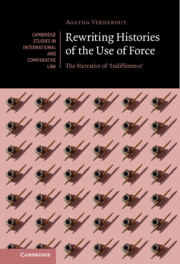Book contents
- Rewriting Histories of the Use of Force
- Cambridge Studies in International and Comparative Law: 160
- Rewriting Histories of the Use of Force
- Copyright page
- Contents
- Foreword
- Acknowledgements
- Abbreviations
- Introduction
- Part I The Use of Force in Nineteenth-Century Doctrine
- 1 The ‘Use of Force’ in the Nineteenth Century
- 2 The Use of Force in Writings of ‘Naturalist’ Inclination
- 3 The Use of Force in Writings of ‘Eclectic’ Inclination
- 4 The Use of Force in Writings of ‘Positivistic’ Inclination
- Conclusion of Part I
- Part II The Use of Force in Nineteenth-Century Practice
- Part III The Narrative of Indifference in the Twentieth Century
- Conclusion
- Bibliography
- Index
- Cambridge Studies in International and Comparative Law
Conclusion of Part I
from Part I - The Use of Force in Nineteenth-Century Doctrine
Published online by Cambridge University Press: 10 September 2021
- Rewriting Histories of the Use of Force
- Cambridge Studies in International and Comparative Law: 160
- Rewriting Histories of the Use of Force
- Copyright page
- Contents
- Foreword
- Acknowledgements
- Abbreviations
- Introduction
- Part I The Use of Force in Nineteenth-Century Doctrine
- 1 The ‘Use of Force’ in the Nineteenth Century
- 2 The Use of Force in Writings of ‘Naturalist’ Inclination
- 3 The Use of Force in Writings of ‘Eclectic’ Inclination
- 4 The Use of Force in Writings of ‘Positivistic’ Inclination
- Conclusion of Part I
- Part II The Use of Force in Nineteenth-Century Practice
- Part III The Narrative of Indifference in the Twentieth Century
- Conclusion
- Bibliography
- Index
- Cambridge Studies in International and Comparative Law
Summary
The aim of this first part of the book was to question the first backbone of the indifference-narrative by testing the assumption according to which the nineteenth and early twentieth century authors who asserted the existence of rules regulating the use of force were foremost naturalists. Modern day literature, indeed, often argues that pre-Versailles international lawyers generally recognised that the use of force was beyond legal regulation and that the authors who did not were the ‘naturalist’ exception. Trying to have as broad a perspective and encompass as many nineteenth and early twentieth century textbooks as possible, it has not only shown that the idea that rules regulated resort to armed force was widespread among the scholarship, but also that this belief was not the prerogative of the ‘naturalists’. With few exceptions, in fact, authors of all theoretical inclinations asserted that the use of force, whether it took the form of ‘measures short of war’ or of war, was not an absolute right of States. The use of force was legitimate, but only in certain circumstances – that is to say as an exception, not as a rule.
- Type
- Chapter
- Information
- Rewriting Histories of the Use of ForceThe Narrative of ‘Indifference', pp. 107 - 112Publisher: Cambridge University PressPrint publication year: 2021

